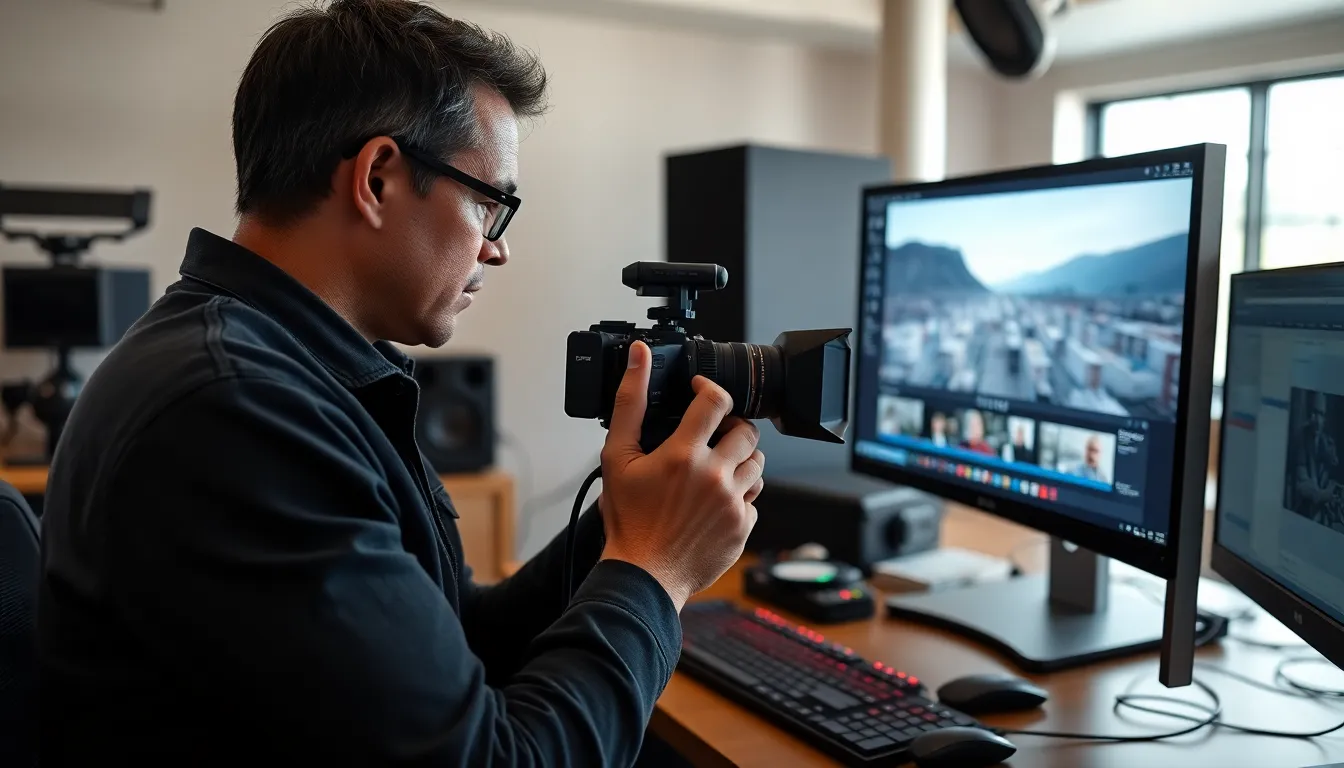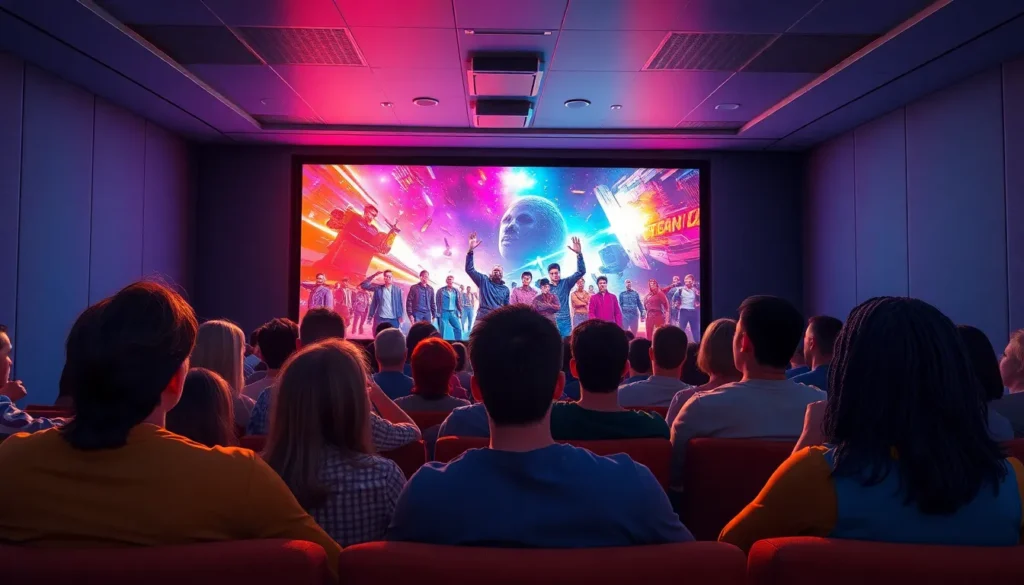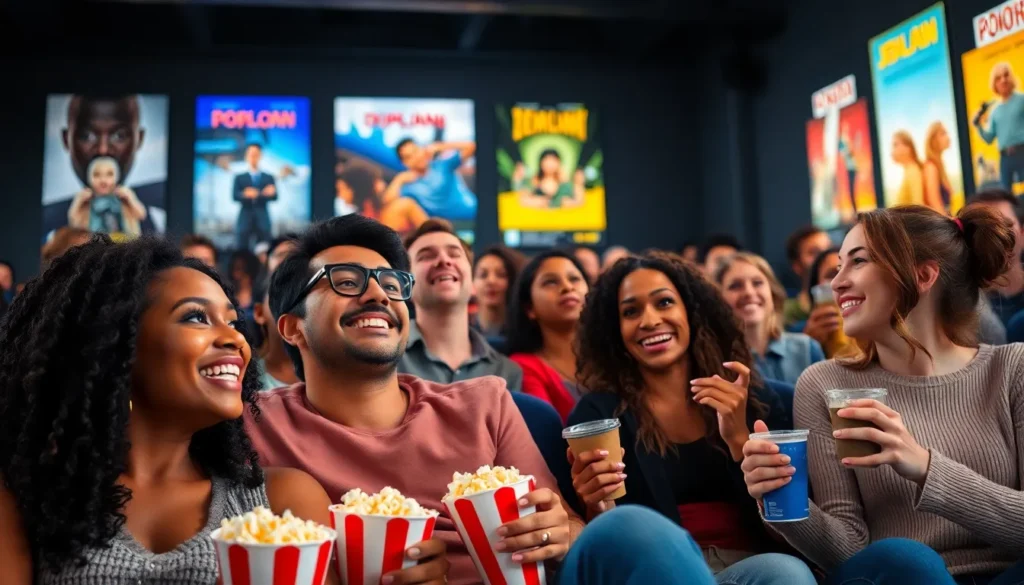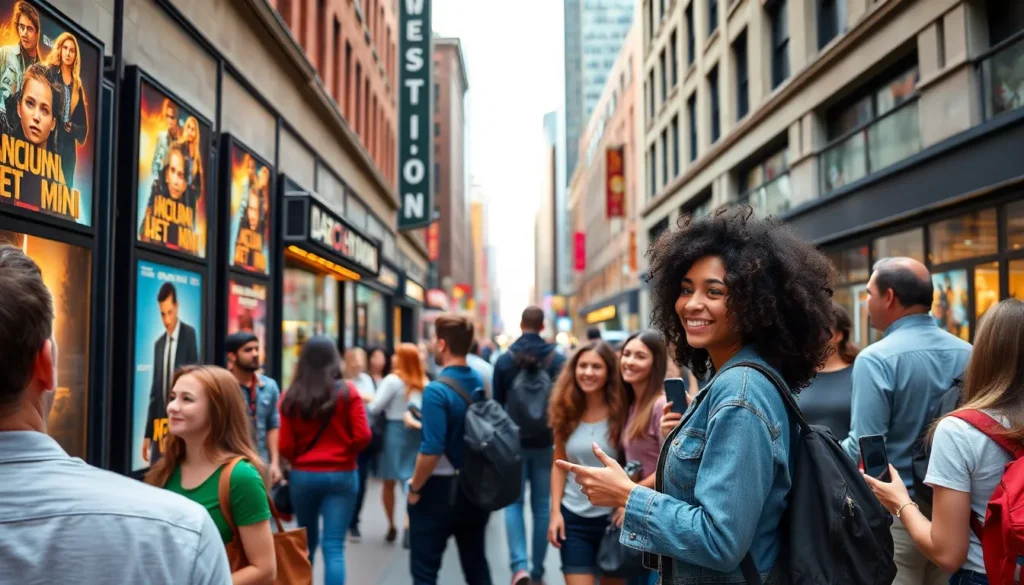Modern cinema isn’t just a bunch of flickering images on a screen; it’s a wild ride through the imagination that keeps audiences glued to their seats. With cutting-edge technology and storytelling that pushes boundaries, today’s films are a feast for the senses. Gone are the days of popcorn flicks; now it’s all about immersive experiences that can make you laugh, cry, or even question your life choices—all in two hours or less.
From blockbuster superheroes to indie gems, modern cinema reflects the world in ways that are both relatable and utterly bizarre. It’s a vibrant tapestry of genres, styles, and voices that invites everyone to grab a seat and enjoy the show. So, whether you’re a casual viewer or a die-hard cinephile, buckle up—modern cinema is here to entertain, challenge, and maybe even inspire a few awkward conversations at the water cooler.
Modern Cinema
Modern cinema represents a significant shift in how films engage audiences. It integrates advanced technology, compelling narratives, and diverse genres, creating an immersive viewing experience. Filmmakers leverage digital effects, high-definition sound, and VR elements to enhance storytelling.
Blockbuster films often dominate the box office, showcasing elaborate visual effects and star-studded casts. These productions attract large audiences, reflecting popular culture’s trends and values. Indie films, in contrast, take creative risks. They often explore unique themes and offer fresh perspectives that resonate with niche audiences.
Streaming platforms revolutionize film distribution. They provide instant access to an extensive library of titles, from classics to contemporary releases. Viewers enjoy the convenience and flexibility of watching movies anytime and anywhere. This accessibility contributes to a broader appreciation of global cinema.
Diverse storytelling flourishes in modern cinema. Films addressing social issues, identity, and relationships encourage discussions among audiences. Strong female leads and underrepresented voices reshape industry norms, ensuring a more inclusive landscape.
Festival circuits highlight innovative filmmakers, providing them with a platform to showcase their work. Events such as Sundance and Cannes spotlight emerging talent while facilitating connections within the industry. These opportunities foster creativity and inspire future projects.
Modern cinema thrives on technological advancements, diverse perspectives, and engaging narratives. Audiences experience a rich tapestry of film that challenges conventions and sparks conversation.
Evolution Of Film Techniques

Modern cinema reflects a remarkable evolution in film techniques, driven by advancements in technology and creativity. Transforming how stories are told, these techniques enhance the viewing experience.
Digital Filmmaking
Digital filmmaking revolutionized the production process. Filmmakers use digital cameras that capture high-resolution images, offering sharper visuals than traditional film. Editing software enables quick adjustments, facilitating faster post-production. Filmmaking on a digital platform drastically reduces costs, allowing more filmmakers to create content without significant financial backing. Enhanced accessibility of digital tools has democratized film creation, empowering aspiring filmmakers to tell their stories.
Special Effects Advancements
Special effects advancements have significantly transformed cinematic storytelling. CGI technology creates lifelike animations, allowing filmmakers to visualize scenes previously deemed impossible. Innovations such as motion capture enable realistic character movements, blurring the line between reality and fantasy. Practical effects continue to complement CGI, with methods like animatronics bringing characters to life. These advancements engage audiences, immersing them in vivid and imaginative worlds, thus expanding the boundaries of creative storytelling.
Trends Shaping Modern Cinema
Modern cinema experiences a dynamic shift driven by technology and creative storytelling. Key trends reflect changing audience preferences and industry innovations.
Streaming Services Influence
Streaming platforms play a critical role in the evolution of film distribution. These services provide instant access to vast libraries of titles, transforming viewing habits. Audiences now enjoy on-demand content at their convenience, leading to a surge in global cinema appreciation. Data shows that over 70% of viewers prefer streaming to traditional cinema for its accessibility and variety. Popular platforms, such as Netflix and Amazon Prime, invest heavily in original content, attracting top talent and innovative creators. This influx of diverse films challenges traditional production norms and encourages experimentation, often resulting in unique storytelling perspectives.
Diverse Storytelling
Diverse storytelling emerges as a powerful trend in modern filmmaking. Films tackling social issues resonate deeply with audiences seeking representation. Strong female leads and underrepresented voices gain prominence, shifting industry standards. Reports indicate that films featuring diverse casts earn higher box office revenues, emphasizing audience demand for inclusivity. Emerging filmmakers showcase culturally rich narratives, expanding the conversation around race, gender, and identity. Initiatives such as the #OscarsSoWhite movement underscore the necessity for broader representation on screen. This evolution not only enriches the cinematic landscape but also fosters meaningful dialogue around important themes.
Major Figures In Modern Cinema
Modern cinema features a diverse array of influential figures. These filmmakers and actors shape trends and drive narratives that resonate with contemporary audiences.
Directors To Watch
Emerging talents are transforming the industry with fresh perspectives. Greta Gerwig stands out for her unique storytelling in films like “Lady Bird” and “Barbie,” combining humor and depth. Jordan Peele captivates audiences with his thought-provoking horror films, including “Get Out” and “Us.” Likewise, Bong Joon-ho’s “Parasite” redefined genre boundaries, earning acclaim globally. Each director pushes creative limits, exploring social themes and innovative techniques. Their work consistently challenges conventions, inspiring the next generation of filmmakers.
Impactful Actors
Leading actors today are redefining their roles and breaking stereotypes. Viola Davis brings powerful performances that highlight marginalized voices in films like “Fences” and “Ma Rainey’s Black Bottom.” Timothée Chalamet captivates viewers with his performances in “Call Me by Your Name” and “Dune,” showcasing emotional depth and versatility. Florence Pugh shines in projects such as “Little Women” and “Midsommar,” proving her range as an actress. Each actor’s commitment to diverse storytelling elevates narratives, drawing attention to important issues and engaging viewers more deeply. Their influence reflects the evolving tastes of modern audiences.
Future Of Modern Cinema
Emerging technologies will continue to shape the future of modern cinema. Virtual reality and augmented reality are expected to play significant roles, providing fully immersive experiences that engage viewers on a new level. Accessibility remains a priority, with advancements in streaming technology ensuring more people can access diverse film content from home.
Industry data indicates that over 70% of audiences now lean towards streaming services, influencing how films are produced and marketed. Streaming platforms will likely increase their investment in original programming, resulting in an even broader range of genres and storytelling styles. Independent filmmakers benefit from this trend, as they gain platforms to showcase their innovative ideas without the constraints of traditional distribution.
Representation in cinema is expected to evolve significantly as well. Films that feature diverse casts and address social issues reflect audience demand for inclusivity. Reports demonstrate that films with varying perspectives enjoy higher box office revenues, emphasizing the importance of diverse storytelling in meeting viewer expectations.
Festival circuits such as Sundance and Cannes will keep serving as crucial platforms for discovering innovative filmmakers. Future projects are likely to be inspired by the creativity found in these events, pushing boundaries and encouraging experimentation. Technological advancements in production techniques will enhance filmmaking processes further, allowing for reduced production costs while maintaining high quality.
Major figures in modern cinema will continue redefining narratives and championing inclusivity. Emerging talents such as Greta Gerwig and Jordan Peele will influence trends and challenge traditional narratives. Furthermore, established actors like Viola Davis and Timothée Chalamet will keep bringing attention to marginalized voices, shaping industry norms for years to come.
Conclusion
Modern cinema stands at a dynamic crossroads where technology and storytelling converge to create unparalleled experiences. The shift towards inclusivity and diverse narratives reflects a growing demand from audiences eager for representation and authenticity. As filmmakers embrace new technologies and innovative techniques, they continue to push boundaries and challenge traditional norms.
With streaming platforms revolutionizing access to films, viewers can explore a rich variety of genres and themes from around the globe. This evolution not only enhances the cinematic experience but also fosters a deeper connection between filmmakers and their audiences. As the industry continues to evolve, modern cinema promises to inspire, entertain, and provoke thought for generations to come.



